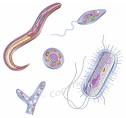
|
The "Green" That Protects Your Tummy
(Along with Safety-First Approaches)
by Alice Osborne

Any fan of Mexican food is familiar with cilantro. But here’s something you may not know about it: The pungent green could fend off gut-cramping illness.
Potent compounds in cilantro appear to be quite a match against a strain of salmonella common in food poisoning.
Bacteria Busters
 When salmonella invades your gastrointestinal tract . . . well, we won’t go into graphic detail. Suffice it to say that it quickly spoils a summer outing! But chopping some cilantro into your pool-party salsa just might keep the dip safer, thanks to the strong antibacterial action of substances in the green. And add extra onions to your salsa for good measure. They help battle salmonella, too.
And speaking of onions, here’s how to chop them without all the tears:
 Start with a SHARP chef’s knife Start with a SHARP chef’s knife
Trim stem end; cut in half through the root end
Peel back skin on both halves, leaving the root end attached
Make horizontal cuts parallel to cutting board, cutting to, but not through the root
Make lengthwise vertical cuts almost, but not quite through the root
Cut across width of onion to chop into small pieces
 To keep your picnic and barbecue foods from turning on you later, practice these other tips: To keep your picnic and barbecue foods from turning on you later, practice these other tips:
Don’t go by looks. Ground beef can be undercooked even if it’s brown. Here are the safe cooking temps for red meat, fish, and poultry:
Use a food thermometer to ensure that your beef, fish, and chicken reach the temperatures set by the U.S. Department of Agriculture:
 Steaks, roasts, and fish -- 62.8 degrees C (145 degrees F) Steaks, roasts, and fish -- 62.8 degrees C (145 degrees F)
Pork and ground beef -- 71.1 degrees C (160 degrees F)
Chicken breasts -- 76.7 degrees C (170.1 degrees F)
 Wash, wash, and wash again. Wash your before cooking, wash fresh produce before preparing, and wash the food prep area when you’re done. And use plain soap and water. Wash, wash, and wash again. Wash your before cooking, wash fresh produce before preparing, and wash the food prep area when you’re done. And use plain soap and water.
 Hand wipes are popular, but plain old soap and water eradicates germs much more effectively, says recent research. Hand wipes are popular, but plain old soap and water eradicates germs much more effectively, says recent research.
At the very least, wash thoroughly with soap and water before every meal and after every trip to the restroom. Viruses are sturdy little particles that cause illnesses such as hepatitis A, colds, the flu, gastroenteritis, and other ailments. Washing often is one of the best ways to reduce risk of these illnesses. When there’s no access to soap and water, alcohol rubs and hand wipes may offer some protection against certain infectious agents.
Finally, know your bugs:
Bacteria:
 Bacteria are all around—on your hands, countertops, floor - everywhere. Eating a few bacteria usually won’t hurt. However, some types of bacteria in contaminated food can make you sick. Examples of bacteria that cause food poisoning are E. coli, Clostridium perfringens, Bacillus cereus, Staphylococcus, and Salmonella. Bacteria are all around—on your hands, countertops, floor - everywhere. Eating a few bacteria usually won’t hurt. However, some types of bacteria in contaminated food can make you sick. Examples of bacteria that cause food poisoning are E. coli, Clostridium perfringens, Bacillus cereus, Staphylococcus, and Salmonella.
Many types of bacteria grow best in warm, moist places, such as food, if it’s not properly cooled, stored, or heated. However, even if you cook and eat your food promptly, you can still get food poisoning. For example, bacteria can get into cooked food if it touches an unwashed utensil or countertop that was used to prepare uncooked meat. That’s why it is important to wash hands, utensils, and countertops before and after you handle raw meat.
Food, especially beef, can be contaminated as it is prepared for sale to grocery stores. For example, a harmful type of E. coli bacteria might get into food at a slaughterhouse or the butcher.
Salmonella food poisoning is common. It is caused most often by eating food containing raw eggs or undercooked chicken or turkey.
Botulism is a type of food poisoning caused by Clostridium botulinum. These bacteria may grow in places with no oxygen, such as sealed cans and vacuum-packed foods.
Viruses:
 The viruses that commonly cause food poisoning are found in water that has been contaminated with human bowel movements. The viruses get into foods such as oysters, clams, and other shellfish. If you drink the water or eat the seafood raw or partially cooked, you may become ill. The viruses that commonly cause food poisoning are found in water that has been contaminated with human bowel movements. The viruses get into foods such as oysters, clams, and other shellfish. If you drink the water or eat the seafood raw or partially cooked, you may become ill.
Parasites:
 Parasites can also cause food poisoning. The most common type of parasitic food poisoning is called trichinosis. Trichinosis is caused by roundworms in pork. Parasites can also cause food poisoning. The most common type of parasitic food poisoning is called trichinosis. Trichinosis is caused by roundworms in pork.
Symptoms of food poisoning include nausea, vomiting, diarrhea, stomach pain, fever (in some cases).
If you have botulism, you probably will not have a fever, but other symptoms may include blurred vision, fatigue, dry mouth and throat.
Depending on the cause, you may start having symptoms hours to months after you eat contaminated food. The most common types of food poisoning cause symptoms in 30 minutes to 2 days. Some types of food poisoning by shellfish may take only a few minutes to cause symptoms.
Contribute to the Cook'n Club!
DVO would love to publish your article, prose, photography and art as well as your cooking, kitchen and nutrition tips, tricks and secrets. Visit the Newsletter Submission / Win Win for All section in our Forum for more information and details.
|
|



